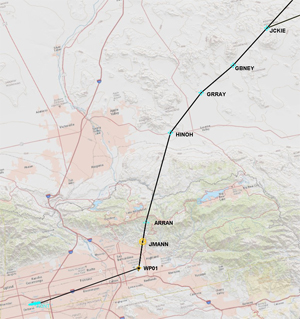Community Engagement — Ontario
Updates
March 8, 2021
The Federal Aviation Administration (FAA) is providing this information to support Ontario International Airport's efforts to notify communities about a taxiway reconstruction project that will result in temporary changes to nighttime flight patterns.
The FAA regularly works with communities and airport operators to develop noise-abatement procedures when possible. For many years at Ontario, FAA and airport authority have used "contra-flow" procedures intended to reduce nighttime aircraft noise in residential communities near the airport. During contra-flow operations, aircraft land from the east and depart to the east between 10 p.m. and 7 a.m. Specifically, arriving aircraft land on Runway 26-Left or 26-Right, and departing aircraft take off from Runway 8-Left or 8-Right.
However, as has happened a number of times in the past, circumstances may prevent FAA from using this procedure. These circumstances are typically safety related and can include low visibility, wind direction and velocity, and runway and taxiway closures.
The Taxiway S reconstruction project that the Ontario International Airport Authority is undertaking will require the closure of the taxiway for significant periods during the project, which the airport expects to continue until the end of October 2021. The taxiway closure will increase the complexity of aircraft movements on the ground, including more runway crossings. Accordingly, FAA will periodically suspend the use of contra-flow procedures during the taxiway project.
The FAA understands the temporary suspensions of the contra-flow procedure will create additional nighttime noise in some neighborhoods, and the agency will continue to support the airport's efforts to notify communities about any future changes.
December 5, 2019
Aircraft that previously used the JCKIE ONE and the EAGLZ routes will be assigned to the JCKIE TWO at all times of day. It will provide both nighttime and daytime overflight reduction to the Lake Arrowhead community. The FAA has cancelled the EAGLZ arrival route with the publication of the JCKIE TWO.
November 6, 2019
Introduction
In April 2017, as part of the Southern California Metroplex project, FAA implemented the EAGLZ satellite-based arrival route into Ontario International Airport (ONT). Aircraft using the EAGLZ flew over Lake Arrowhead, resulting in widespread community concerns.
As part of the post-implementation phase of the SoCal Metroplex project, FAA looked at designing a new route that could address community concerns while maintaining the project's enhanced airspace safety and efficiency benefits. In May 2018, the FAA created a new arrival route for ONT called the JCKIE ONE, which is located east of Lake Arrowhead.
The JCKIE ONE could only be used between approximately 11 p.m. and 6 a.m. because it did not provide the necessary separation with the nearby DSNEE and ROOBY arrival routes, which serve John Wayne Airport and Long Beach Airport, respectively. The DSNEE and ROOBY are not used at night due to curfews at John Wayne Airport and Long Beach Airport. Therefore, FAA was able to use the JCKIE ONE at night.
After implementing the JCKIE ONE, FAA continued to explore additional options to address community concerns about flights that use the EAGLZ during the day. The FAA determined it could modify the JCKIE ONE to create a route that could be used 24 hours a day. This route will be called the JCKIE TWO.
Aircraft that currently use the JCKIE ONE and the EAGLZ will be assigned to the JCKIE TWO at all times of day. It will provide both nighttime and daytime overflight reduction to the Lake Arrowhead community.
The FAA conducted an environmental review of the JCKIE TWO in compliance with the National Environmental Policy Act. The FAA will post its documented environmental review on this website once the JCKIE TWO is published.
The FAA plans to publish and start using the JCKIE TWO on Dec. 5, 2019. The FAA will cancel the EAGLZ arrival route when it publishes the JCKIE TWO.
Implementing the JCKIE TWO will not change runway usage at ONT. The vast majority of aircraft will continue to land from east to west, on Runways 26L and 26R.
March 9, 2018
The FAA has developed Performance Based Navigation (PBN) arrivals and departure procedure into the Ontario International Airport (ONT) as part of the now implemented Southern California Metroplex Project. The FAA issued its final decision on the project on September 2, 2016 and the administrative process is closed. As a legal matter, that decision will not be revisited. During its post-implementation review, FAA heard concerns about overflights from Lake Arrowhead communities.

As part of the post-implementation phase, FAA reviewed all procedures to assess outcomes and verify expected benefits. During this review, the Agency determined it might be operationally feasible to use an alternate arrival path into ONT in some nighttime conditions when the Long Beach Airport (LGB) and the Orange County Airport (SNA) DSNEE and ROOBY STARs no longer conflict with the ONT arrival procedures due to inactivity. Curfews imposed on LGB and SNA operations result in increased available airspace and design options for ONT overnight arrivals.
The FAA completed an environmental review of the proposed JCKIE STAR in accordance with policies and procedures in FAA JO 7400.2L, "Procedures for Handling Airspace Matters," Department of Transportation Order 5610.1C, "Procedures for Considering Environmental Impacts" and FAA Order 1050.1F "Environmental Impacts: Policies and Procedures." The FAA has determined that no significant environmental impacts will occur with the implementation of this procedure and it meets the criteria of a categorical exclusion.
The documentation can be read below.
January 26, 2018
FAA representatives attended the January 25, 2018 meeting of the Lake Arrowhead Municipal Advisory Council. FAA Regional Administrator made a presentation about the airspace procedures recently approved and implemented near Lake Arrowhead as part of the Southern California Metroplex project. He also discussed a new, proposed procedure that may address local community concerns about overflights while maintaining the enhanced airspace safety and efficiency benefits.
